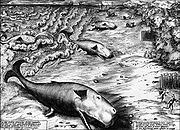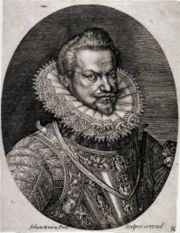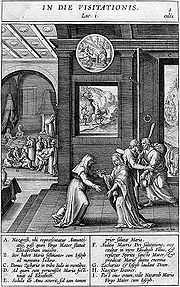
Wierix family
Encyclopedia

Flemish people
The Flemings or Flemish are the Dutch-speaking inhabitants of Belgium, where they are mostly found in the northern region of Flanders. They are one of two principal cultural-linguistic groups in Belgium, the other being the French-speaking Walloons...
dynasty of printmakers in engraving
Engraving
Engraving is the practice of incising a design on to a hard, usually flat surface, by cutting grooves into it. The result may be a decorated object in itself, as when silver, gold, steel, or glass are engraved, or may provide an intaglio printing plate, of copper or another metal, for printing...
in the 16th and early 17th centuries, active in Antwerp and Brussels
Brussels
Brussels , officially the Brussels Region or Brussels-Capital Region , is the capital of Belgium and the de facto capital of the European Union...
.
The first generation of engravers consisted of the three sons of the obscure painter Anton I Wierix:
- Johann or Jan Wierix (1549 – c. 1618),
- Jerome or Hieronymus Wierix (1553–1619) and
- Anthony or Anton II Wierix (c. 1552 – c. 1604).
Anton II's son, Anton III Wierix (1596–1624) completes the engraver members of the family, although his early death prevented him from producing a large oeuvre. All were highly productive, with 2,333 prints catalogued between them, the largest number by Jan. The group were known for their fine attention to detail and superb technique, but were not known for their originality in composition.
Lives

Albrecht Dürer
Albrecht Dürer was a German painter, printmaker, engraver, mathematician, and theorist from Nuremberg. His prints established his reputation across Europe when he was still in his twenties, and he has been conventionally regarded as the greatest artist of the Northern Renaissance ever since...
from this period are still valued by collectors. Who their master was is unknown – it was unlikely to be their father, who had joined the Antwerp artists' Guild of Saint Luke
Guild of Saint Luke
The Guild of Saint Luke was the most common name for a city guild for painters and other artists in early modern Europe, especially in the Low Countries. They were named in honor of the Evangelist Luke, the patron saint of artists, who was identified by John of Damascus as having painted the...
in 1545/6 but is also recorded as a cabinetmaker. Jan and Hieronymus first worked producing book illustrations for the large publishing concern of Christopher Plantin in Antwerp. Hieronymus was first paid by Plantin in 1570, and they both joined the Antwerp artists' Guild of Saint Luke
Guild of Saint Luke
The Guild of Saint Luke was the most common name for a city guild for painters and other artists in early modern Europe, especially in the Low Countries. They were named in honor of the Evangelist Luke, the patron saint of artists, who was identified by John of Damascus as having painted the...
in 1572/3.
Jan probably trained Anton II, and Hieronymus Anton III. The brothers often worked together, but Jan moved to Delft from 1577–79, probably as a result of the Sack of Antwerp
Sack of Antwerp
The sack of Antwerp or the Spanish Fury at Antwerp was an episode of the Eighty Years' War.On 4 November 1576, Spanish tercios began the sack of Antwerp, leading to three days of horror among the population of the city, which was the cultural, economic and financial center of the Netherlands. The...
in 1576, also known as the Spanish Fury. He then returned to Antwerp for nearly 20 years – perhaps his best period – and moved briefly to The Hague
The Hague
The Hague is the capital city of the province of South Holland in the Netherlands. With a population of 500,000 inhabitants , it is the third largest city of the Netherlands, after Amsterdam and Rotterdam...
before settling in Brussels at about the turn of the century, where he remained until his death.
The brothers were recorded as Lutherans in 1585, but as they later did a large amount of work for the Jesuits, it seems probable they converted or reconverted to Catholicism after this date.
All three, but especially Hieronymus, were described by contemporaries as leading disorderly lives, and had long criminal records, mostly for drunkenness and the like, but Hieronymus spent several months in prison in 1579/80 for an accidentally fatal drunken assault on a female tavernkeeper. They may have been let go by Plantin for this reason, and a famous letter from him complained that they only worked for a few days to raise enough money to disappear into the taverns, where he would have to seek them out, pay their bills, and get their tools out of pawn
Pawnbroker
A pawnbroker is an individual or business that offers secured loans to people, with items of personal property used as collateral...
. However the productivity and quality of their work gives a rather different picture. As they grew older they led more regular lives, all marrying with several children, and probably all running workshops with assistants – the portraitist Michiel Jansz van Mierevelt
Michiel Jansz van Mierevelt
Michiel Jansz. van Mierevelt, Mierveld or Mireveldt was a Dutch Golden Age painter.-Biography:He was the son of a goldsmith, who apprenticed him to the copperplate engraver Hieronymus Wierix...
began his training with Hieronymus, although he soon moved to another master. The father of Samuel Dirksz van Hoogstraten
Samuel Dirksz van Hoogstraten
Samuel Dirksz van Hoogstraten was a Dutch painter of the Golden Age.-Biography:Samuel Dirksz van Hoogstraten was born and died in Dordrecht. He was...
was another pupil of Hieronymus. Jan's pupils included Hendrik Hondius I
Hendrik Hondius I
Henrik Hondius I or Hendrik Hondius the Elder , was a Dutch Golden Age engraver, cartographer and publisher.-Biography:He was born in Duffel and settled in The Hague in 1597. According to Cornelis de Bie's Het Gulden Cabinet, his father was Guiliam Hondius, a learned man who moved to Mechelen,...
(1573 – c. 1650). After Anton II died relatively young in 1604, Hieronymus took over his plates and his young son Anton III. Anton III's death at an even younger age brought an end to the family business, although at least one of the brothers' many daughters married an engraver.
Work

Hendrik Goltzius
Hendrik Goltzius , was a Dutch printmaker, draftsman, and painter. He was the leading Dutch engraver of the early Baroque period, or Northern Mannerism, noted for his sophisticated technique and the "exuberance" of his compositions. According to A...
and other Dutch engravers, and they produced few works of this sort.
Their association with the Jesuits began with the illustrations for the Adnotationes et Meditationes in Evangelia, a project iniated by the order's founder, St. Ignatius Loyola before his death in 1556. He had asked the literary Jesuit Jerome Nadal to prepare the text, and 154 drawings had been produced by various artists, mostly Italian. Plantin had agreed to publish the work, but with the disruption of the Spanish Fury of 1576, had not done so by his death. After attempting to find engravers elsewhere, the Jesuits, in the person of Fr Ferdinand Ximenez (recipient of the famous character reference for the brothers mentioned above), took the brothers on. The prints were finally published in a separate volume from the text in 1593, the Evangelicae Historiae Imagines ("Pictures of the Gospel Stories") and were still being reprinted in the 18th century. They were intended as models of faithful depictions of the incidents of the Gospels, and partly as a Counter Reformation riposte to Protestant criticisms of Catholic iconographical tradition. The apparent setting of most interior scenes in a wealthy Antwerp merchant's house does not contribute to the desired effect in modern eyes. Among copies was a version made by Jesuit missionaries in China
Jesuit China missions
The history of the missions of the Jesuits in China is part of the history of relations between China and the Western world. The missionary efforts and other work of the Society of Jesus, or Jesuits, between the 16th and 17th century played a significant role in continuing the transmission of...
in woodblock print form, and editions presented to the Emperors of Ethiopia
Ethiopia
Ethiopia , officially known as the Federal Democratic Republic of Ethiopia, is a country located in the Horn of Africa. It is the second-most populous nation in Africa, with over 82 million inhabitants, and the tenth-largest by area, occupying 1,100,000 km2...
had a considerable influence on the iconography of local artists. Further work for the Jesuits followed. Hieronymus in particular came to specialize in small religious scenes.
Apart from religious works the Wierixs became "the leading purveyors of small-scale printed portraits in the Netherlands", although only Jan appears to have made drawings from the life, and most of his portraits are copied from paintings, drawings or prints by others (very often of international figures). Some of Jan's drawings were made to be engraved, but others were sold as finished objects. The British Museum
British Museum
The British Museum is a museum of human history and culture in London. Its collections, which number more than seven million objects, are amongst the largest and most comprehensive in the world and originate from all continents, illustrating and documenting the story of human culture from its...
has 44, including 19 illustrating the Book of Genesis, and a large composition of Diana surprised by Actaeon
Actaeon
Actaeon , in Greek mythology, son of the priestly herdsman Aristaeus and Autonoe in Boeotia, was a famous Theban hero. Like Achilles in a later generation, he was trained by the centaur Chiron....
. Most are on vellum
Vellum
Vellum is mammal skin prepared for writing or printing on, to produce single pages, scrolls, codices or books. It is generally smooth and durable, although there are great variations depending on preparation, the quality of the skin and the type of animal used...
.
Further reading
- Mauquoy-Hendrickx, Marie, Les Estampes des Wierix, 4 vols., 1983. (Full title:Les estampes des Wierix conservées au cabinet des estampes de la Bibliothèque Royale Albert Ier: Catalogue raisonné, enrichi de notes prises dans diverses autres collections; Text in French), ISBN 1-55660-225-1
- New Hollstein series. Several volumes 2003-7
External links
- online Bryan's Dictionary of Painters and Engravers, Biographical and Critical has some more details & lists works held especially fine in the 19th century.
- British Museum online database has 1,217 items for Wierix, 264 with images.
- San Francisco Museums 264 items online

